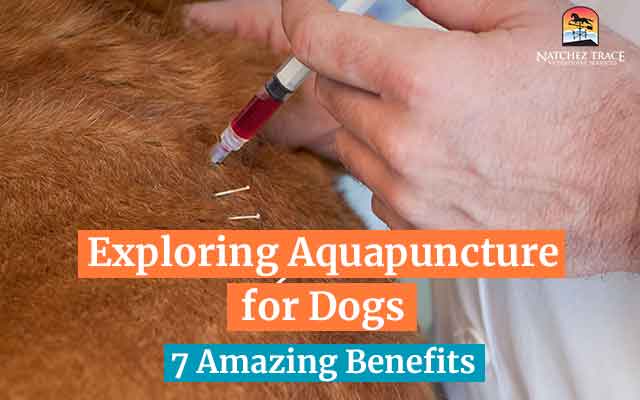Picture a therapy that pairs ancient acupuncture principles with the precision of modern science. That’s aquapuncture for dogs—a tailored approach designed to enhance your dog’s health in unique ways. Dr. Smith likes to refer to aquapuncture as “biopuncture”.
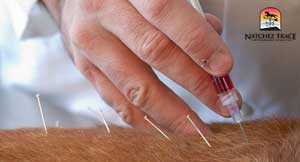 As a pet owner seeking holistic care for your furry friend, you’re always on the lookout for innovative methods that can truly make a difference.
As a pet owner seeking holistic care for your furry friend, you’re always on the lookout for innovative methods that can truly make a difference.
Aquapuncture steps into this space as a promising alternative therapy, offering a fresh perspective on how to address your dog’s health concerns.
Explore aquapuncture for dogs—a therapy specialized to cater specifically to your furry companion’s needs. From unraveling the core principles to uncovering the potential benefits and practical applications, get to know this innovative avenue that holds promise for elevating your dog’s overall well-being.
Understanding Aquapuncture for Dogs
Aquapuncture, a fusion of ancient acupuncture techniques and modern veterinary care, offers a unique approach to address various health concerns in dogs. Aquapuncture is another term for biopuncture.
Unlike traditional acupuncture, which involves inserting fine needles into specific points on a dog’s body, aquapuncture introduces fluids—commonly vitamins, herbal extracts, or other therapeutic solutions—into these acupuncture points.
 This technique harnesses the principles of acupuncture, where these points correspond to energy pathways or meridians in the body. By strategically injecting fluids, aquapuncture aims to stimulate these points, promoting a sustained therapeutic effect through the prolonged presence of these solutions.
This technique harnesses the principles of acupuncture, where these points correspond to energy pathways or meridians in the body. By strategically injecting fluids, aquapuncture aims to stimulate these points, promoting a sustained therapeutic effect through the prolonged presence of these solutions.
The injected fluids can stay within the points for an extended period, providing continuous stimulation and potential therapeutic benefits.
This approach is particularly useful for dogs who might not tolerate traditional needle-based acupuncture or in cases where sustained stimulation is required for optimal therapeutic outcomes.
Aquapuncture isn’t a one-size-fits-all solution and is often tailored to address specific conditions in dogs. Its application can range from managing musculoskeletal issues like arthritis to alleviating digestive problems or supporting overall wellness.
This innovative therapy, backed by ancient wisdom and adapted to modern veterinary practices, offers pet owners a nuanced and alternative avenue to support their dog’s health and well-being.
However, as with any medical intervention, it’s crucial for aquapuncture procedures to be performed by trained veterinary professionals to ensure its safety and effectiveness for your furry companion.
Benefits of Aquapuncture for Dogs
While each dog’s response to aquapuncture may vary, the therapeutic benefits it offers across a spectrum of conditions make it an appealing option for pet owners seeking alternative or complementary therapies to support their dog’s health and quality of life.
Here’s a list of benefits to ponder:
 Pain Management: Aquapuncture serves as an effective tool in managing pain for dogs dealing with various conditions such as arthritis, joint problems, or post-surgery discomfort. The sustained stimulation of acupuncture points with therapeutic fluids can help alleviate pain and improve mobility.
Pain Management: Aquapuncture serves as an effective tool in managing pain for dogs dealing with various conditions such as arthritis, joint problems, or post-surgery discomfort. The sustained stimulation of acupuncture points with therapeutic fluids can help alleviate pain and improve mobility.- Extended Therapeutic Effects: Unlike traditional acupuncture, where needles are inserted and removed, aquapuncture allows for the prolonged presence of therapeutic fluids in the acupuncture points. This sustained stimulation can lead to longer-lasting therapeutic effects, providing continuous relief for the dog.
- Holistic Wellness: Aquapuncture supports holistic wellness in dogs by addressing a range of health concerns beyond pain management. It can aid in managing digestive issues, improving skin conditions, alleviating stress and anxiety, and supporting overall vitality.
- Individualized Treatment: One of the key benefits of aquapuncture is its adaptability. We can customize the fluids injected into acupuncture points based on the specific needs of your dog. This personalized approach ensures tailored treatment for optimal results.
- Reduced Sensitivity: For dogs that may be sensitive to traditional acupuncture needles, aquapuncture offers a gentler alternative. The introduction of fluids into the acupuncture points can be more tolerable for sensitive dogs while still providing therapeutic benefits.
- Complementary Therapy: Aquapuncture serves as a valuable complementary therapy alongside conventional veterinary care. It can be integrated into a comprehensive treatment plan, enhancing the effectiveness of other treatments and promoting overall well-being.
- Minimized Side Effects: Compared to some pharmaceutical interventions, aquapuncture generally presents fewer side effects or adverse reactions. When performed by our skilled team, it offers a natural and minimally invasive approach to canine health care.
Conditions Treated with Aquapuncture in Dogs
Explore the diverse spectrum of health concerns that can be relieved through aquapuncture.
From musculoskeletal issues and digestive disorders to skin conditions, respiratory problems, and beyond, aquapuncture emerges as a promising complementary therapy, offering hope for dogs facing a range of conditions.
- Arthritis and Joint Issues: Aquapuncture is highly beneficial for dogs suffering from arthritis or joint problems. The sustained stimulation of specific acupuncture points with therapeutic fluids helps reduce inflammation, alleviate pain, and improve joint mobility, enhancing the dog’s quality of life.
- Digestive Disorders: Dogs experiencing digestive issues like vomiting, diarrhea, or constipation can benefit from aquapuncture. The targeted introduction of fluids into acupuncture points aids in regulating digestive functions, promoting better gut health, and easing gastrointestinal discomfort.
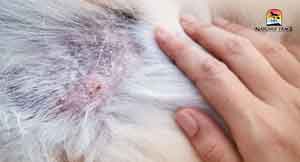 Skin Conditions and Allergies: Aquapuncture complements traditional treatments for dogs dealing with skin problems or allergies. The therapy helps soothe irritated skin, reduce itching, and minimize allergic reactions, contributing to improved skin health.
Skin Conditions and Allergies: Aquapuncture complements traditional treatments for dogs dealing with skin problems or allergies. The therapy helps soothe irritated skin, reduce itching, and minimize allergic reactions, contributing to improved skin health.- Musculoskeletal Problems: Beyond arthritis, aquapuncture assists in managing various musculoskeletal issues in dogs. It can be beneficial for conditions such as muscle strains, spinal problems, or injuries, promoting healing and relieving discomfort.
- Stress and Anxiety: Dogs experiencing stress, anxiety, or behavioral issues may find relief through aquapuncture. The therapy aids in calming the nervous system, reducing anxiety-related behaviors, and promoting relaxation in anxious dogs.
- Respiratory Disorders: Aquapuncture can support dogs with respiratory problems by helping improve breathing patterns and enhancing overall respiratory function. While not a primary treatment, it can be a complementary approach in managing certain respiratory conditions.
- Chronic Pain Management: Dogs suffering from chronic pain conditions, not limited to arthritis, but including conditions like neuropathic pain or certain neurological disorders, may experience relief and improved comfort through aquapuncture.
Aquapuncture, tailored to the specific needs of each dog, offers a versatile therapeutic approach that can complement conventional veterinary treatments.
It addresses a range of conditions by promoting natural healing mechanisms, reducing discomfort, and supporting the overall well-being of our canine companions.
As always, consulting a qualified veterinarian experienced in aquapuncture is essential to determine its suitability for individual dogs and their specific health concerns.
Aquapuncture Procedure for Dogs
Aquapuncture procedures for dogs require a skilled and experienced veterinary professional trained in this technique. The careful selection of acupuncture points, appropriate therapeutic fluids, and adherence to sterile and safe practices are fundamental to the success and safety of the treatment.
Communication between you and Dr. Smith is vital to ensure the best possible outcomes for the dog’s health.
- Evaluation and Assessment: Before initiating aquapuncture, a thorough evaluation is crucial. Dr. Smith will assess your dog’s health, identify specific health concerns, and determine the appropriate acupuncture points for treatment.
- Selection of Therapeutic Fluids: Dr. Smith selects the appropriate therapeutic fluids based on your dog’s condition and individual needs. These fluids can include vitamins, herbal extracts, or other solutions tailored to address the specific health issue being targeted.
- Acupuncture Point Identification: Similar to traditional acupuncture, specific acupuncture points are selected based on your dog’s condition. These points correspond to energy pathways or meridians in the body, and Dr. Smith strategically identifies and marks these points for injection.
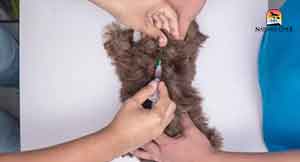 Injection Process: Using sterile techniques, Dr. Smith administers the therapeutic fluids into the identified acupuncture points. The process involves gentle and precise injections, aiming to stimulate the points and initiate therapeutic effects.
Injection Process: Using sterile techniques, Dr. Smith administers the therapeutic fluids into the identified acupuncture points. The process involves gentle and precise injections, aiming to stimulate the points and initiate therapeutic effects.- Monitoring and Follow-up: Post-treatment, your dog is monitored for any immediate reactions or responses. Multiple sessions might be recommended based on the condition being treated, and regular follow-ups with Dr. Smith are essential to assess progress and adjust the treatment plan if needed.
- Holistic Approach: Aquapuncture is often integrated into a holistic treatment plan, complementing conventional veterinary care. It can be used alongside other therapies or medications to maximize its effectiveness and support your dog’s overall health and well-being.
- Pet Owner Involvement: You play a crucial role in the success of aquapuncture. You need to follow Dr. Smith’s instructions, ensure your dog’s comfort during sessions, and communicate any changes or observations regarding your dog’s response to treatment.
Is It Safe for My Dog?
Ensuring the well-being of our beloved canine companions is paramount, especially when exploring alternative therapies like aquapuncture. Understanding the safety measures and considerations surrounding this innovative technique is crucial.
Let’s navigate the key factors ensuring the safe and effective application of aquapuncture. Understanding these vital aspects empowers you to make informed decisions and prioritize your dog’s health and safety in exploring this therapeutic avenue.
- Professional Expertise: Safety in aquapuncture for dogs relies heavily on the expertise of the veterinary professional performing the procedure. A trained and experienced veterinarian like Dr. Smith skilled in acupuncture techniques and the administration of therapeutic fluids ensures safe and effective treatment.
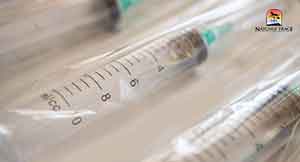 Sterile Practices: Maintaining sterile conditions during aquapuncture sessions is crucial to prevent infections or complications. The use of sterile needles and equipment, proper handling of therapeutic fluids, and adherence to hygiene protocols are paramount for your dog’s safety.
Sterile Practices: Maintaining sterile conditions during aquapuncture sessions is crucial to prevent infections or complications. The use of sterile needles and equipment, proper handling of therapeutic fluids, and adherence to hygiene protocols are paramount for your dog’s safety.- Individual Response: Dogs may respond differently to aquapuncture. While most dogs tolerate the procedure well, some may experience mild discomfort or transient reactions. Monitoring the dog’s response during and after the session helps identify any adverse reactions promptly.
- Appropriate Fluid Selection: The selection of therapeutic fluids is tailored to your dog’s specific condition. Careful consideration of the type and concentration of fluids used ensures that they are safe and beneficial for your dog, minimizing the risk of adverse effects.
- Potential Risks: Although rare, potential risks associated with aquapuncture for dogs include localized reactions, bruising, or infection at the injection site. These risks are minimized with proper technique and sterile practices.
- Pet Health Assessment: Before initiating aquapuncture, a comprehensive health assessment of your dog is essential. Pre-existing health conditions, allergies, or sensitivities are taken into account to determine the suitability and safety of aquapuncture for your dog.
- Communication and Follow-ups: Open communication between you and Dr. Smith is crucial. You should discuss any concerns or observations about your dog’s response to aquapuncture. Regular follow-ups with Dr. Smith allow for adjustments to the treatment plan if needed.
- Consideration of Suitability: Not all dogs may be suitable candidates for aquapuncture. Factors such as overall health, specific health conditions, and individual temperament should be considered to ensure the safety and appropriateness of the procedure for each dog.
- Integrated Care: Aquapuncture is often part of an integrated care plan. It complements conventional veterinary treatments but should not replace essential veterinary care when necessary.
By prioritizing safety measures, conducting thorough assessments, and ensuring proper administration by qualified professionals, aquapuncture can be a safe and valuable therapeutic option for dogs, contributing to their improved health and well-being.
In Conclusion
The unique procedure emerges as a promising frontier in veterinary care. This technique holds significant potential in enhancing the well-being of our canine companions.
From its tailored approach to addressing various conditions to its role in managing pain, promoting holistic wellness, and offering a gentler alternative for sensitive dogs, aquapuncture stands as a versatile and complementary therapy.
However, this article underscores the importance of safety and thoughtful considerations. The expertise of trained  professionals like Dr. Smith and his team, sterile practices, individualized treatment plans, and open communication between veterinarians and pet owners form the pillars of safe and effective aquapuncture procedures.
professionals like Dr. Smith and his team, sterile practices, individualized treatment plans, and open communication between veterinarians and pet owners form the pillars of safe and effective aquapuncture procedures.
As guardians of your dogs’ health, the integration of aquapuncture into a holistic care plan offers a pathway to support their vitality and comfort. Yet, it’s crucial to remember that aquapuncture is part of a comprehensive approach to care and should be administered under the guidance of qualified veterinary professionals. Make an appointment today!
People Also Ask:
- Is aquapuncture safe for all dogs? The procedure can be safe for many dogs, but suitability varies. It’s crucial to assess each dog individually. Factors such as overall health, existing conditions, and temperament influence the suitability of aquapuncture. Consulting a qualified veterinarian experienced in this technique helps determine if aquapuncture is safe and appropriate for your dog.
- How many aquapuncture sessions does a dog typically need? The number of sessions varies based on the dog’s condition and response to treatment. Some dogs might show improvement after a few sessions, while others may require a more extended treatment plan. We typically design a treatment schedule tailored to your dog’s specific needs, often involving multiple sessions over a specified period. Regular assessments and follow-ups with Dr. Smith guide the treatment’s duration.
- Are there any risks or side effects associated with aquapuncture? While aquapuncture is generally safe, occasional risks exist. These can include mild reactions at the injection site, bruising, or, rarely, infections. Most dogs tolerate aquapuncture well, but individual reactions may vary. Choosing NTVS ensures proper technique, sterile practices, and minimizes potential risks. You should observe your dog post-treatment and promptly communicate any concerns to Dr. Smith.

